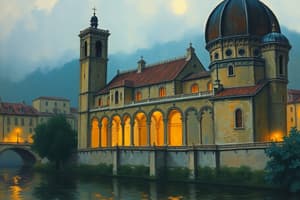Podcast
Questions and Answers
What was the primary purpose of Romanesque architecture during the 11th and 12th centuries?
What was the primary purpose of Romanesque architecture during the 11th and 12th centuries?
- To showcase political power
- To create extravagant residential spaces
- To reflect religious devotion and accommodate pilgrims (correct)
- To promote scientific advancements
Which architectural feature is NOT commonly associated with Romanesque buildings?
Which architectural feature is NOT commonly associated with Romanesque buildings?
- Thick walls
- Flying buttresses (correct)
- Barrel vaults
- Rounded arches
What is the purpose of the tympanum in Romanesque churches?
What is the purpose of the tympanum in Romanesque churches?
- To support the ceiling structure
- To serve as a decorative element only
- To depict biblical scenes for the public (correct)
- To provide ventilation
Which example features a cruciform shape that reflects Christ's cross?
Which example features a cruciform shape that reflects Christ's cross?
What type of vault was commonly used in Romanesque architecture to create tunnel-like ceilings?
What type of vault was commonly used in Romanesque architecture to create tunnel-like ceilings?
Which of the following was a common theme for frescoes in Romanesque churches?
Which of the following was a common theme for frescoes in Romanesque churches?
What distinct feature is characteristic of the Pisa Cathedral Complex?
What distinct feature is characteristic of the Pisa Cathedral Complex?
What signifies religious narratives in the capitals of Romanesque columns?
What signifies religious narratives in the capitals of Romanesque columns?
Flashcards
Romanesque Art Period
Romanesque Art Period
The time period during which Romanesque art flourished, spanning from the 11th to the 12th centuries, preceding the Gothic architecture style.
Basilica Plan
Basilica Plan
A prominent feature of Romanesque churches, characterized by long, rectangular naves flanked by aisles and ending with an apse.
Tympanum
Tympanum
A defining element of Romanesque sculpture, often found above church portals, showcasing scenes like the Last Judgment or Christ in Majesty.
Massive Structures
Massive Structures
Signup and view all the flashcards
Barrel Vault
Barrel Vault
Signup and view all the flashcards
Cruciform Shape
Cruciform Shape
Signup and view all the flashcards
Romanesque Painting
Romanesque Painting
Signup and view all the flashcards
Groin Vault
Groin Vault
Signup and view all the flashcards
Study Notes
Romanesque Art: Key Characteristics and Examples
- Historical Context (11th-12th Centuries): This period preceded Gothic architecture. Art and architecture focused on religious devotion, accommodating pilgrims, and conveying biblical stories.
Architectural Features
- Massive Structures: Buildings featured heavy, thick walls for strength.
- Rounded Arches: Drawing inspiration from Roman designs.
- Barrel Vaults: Continuous arched ceilings, creating a tunnel-like effect.
- Groin Vaults: Intersection of barrel vaults creating robust support.
- Towers: Square or cylindrical, often flanking church facades.
- Small Windows: Limited openings due to the massive walls.
Building Plans
- Basilica Plan: A long rectangular nave, with side aisles and an apse.
- Cruciform Shape: A cross-like structure, with transepts and ambulatories (covered walkways) for pilgrims, highlighting the importance of Christ. This design accommodated the flow of pilgrims.
Sculptural Decoration
- Tympanum: Semi-circular carvings above church portals depicting biblical events (e.g., the Last Judgment, Christ in Majesty), serving as visual storytelling to an illiterate populace.
- Capitals: Sculpted decorations adorning column tops, incorporating various themes (animals, saints, biblical narratives).
Painting and Frescoes
- Style: Two-dimensional figures with symbolic colors.
- Locations: Featured on church walls and ceilings.
- Themes: Depicting biblical stories, portraits of saints, and representations of Christ.
Regional Variations
- France: Characterized by elaborate portal decorations and barrel-vaulted pilgrimage churches (e.g., Saint-Sernin).
- Italy: Showed Roman influence, with striped marble facades and rounded arches (as seen in the Pisa Cathedral complex).
- Germany: Used alternating columns and arches like the Speyer Cathedral.
Key Examples by Region
- Spain (Santiago de Compostela): Cruciform plan with an ambulatory for pilgrims to accommodate large numbers.
- France (Saint-Sernin): A large pilgrimage church with barrel vaults and a significant nave.
- France (Autun Cathedral): Famous for its tympanum carving by Gislebertus depicting the Last Judgment.
- Spain (San Clemente): Notable for a fresco depicting Christ Pantocrator.
- Italy (Pisa Cathedral Complex): Showcases Roman influences with a leaning bell tower and striped facade.
- Germany (Speyer Cathedral): Known for its groin vaulting.
Studying That Suits You
Use AI to generate personalized quizzes and flashcards to suit your learning preferences.




